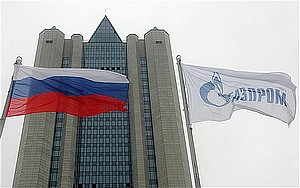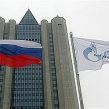
GAZPROM THREATENS TO REDUCE SUPPLIES TO UKRAINE
Publication: Eurasia Daily Monitor Volume: 4 Issue: 184
By:

On October 2 Gazprom warned Ukraine via mass media that it would reduce gas deliveries from November onwfard, unless Ukraine pays $1.3 billion dollar worth of arrears to Gazprom. According to company spokesman Sergei Kupriyanov, these arrears accumulated for gas supplied during the nine-month period since January 1, 2007.
Characteristically, Gazprom resorted to the media weapon before informing the Ukrainian government or presidency. Kyiv had not yet been officially notified by October 3, when Prime Minister Viktor Yanukovych dispatched Fuel and Energy Minister Yuriy Boyko to Moscow for emergency talks with Gazprom. They agreed that Ukraine would pay those arrears until November 1 to avoid a cut in supplies.
This situation increases the threat to Ukrainian ownership of the gas-transit network. The accumulation of Ukrainian debts to Gazprom in 2007 was predictable early in the year (see EDM, February 7, 21). Indeed, Gazprom with its middleman firms and elements in the Ukrainian government had set up a mechanism for debt-accumulation through the January 4 and February 2, 2006, gas supply agreements. That mechanism has pushed the state company Naftohaz Ukrainy toward de facto insolvency in 2006-2007, leaving it open to Russian demands for “joint control of the gas transit system in lieu of debt repayment.
That mechanism has operated from 2006 to date essentially as follows. Gazprom, monopoly buyer of Turkmen gas for Ukraine, sells those volumes — along with some additional Russian-produced volumes — to RosUkrEnergo, the monopoly intermediary between Gazprom and Ukraine. Gazprom’s proxy RosUkrEnergo is a parity joint venture of Gazprom with two allied Ukrainian businessmen, the notorious Dmytro Firtash being a key figure. RosUkrEnergo sells that gas at the Ukrainian border to its proxy within Ukraine, UkrGazEnergo, a joint venture of RosUkrEnergo with Gazprom-friendly elements within Naftohaz and other Ukrainian offices. UkrGazEnergo has been awarded the lucrative Ukrainian market of industrial consumers of gas, whereas Naftohaz itself has been left with the barely solvent or insolvent “social market” for gas — that is, mainly municipal utilities and the residential consumers — where gas prices are regulated below the actual costs.
These arrangements have drastically cut Naftohaz’s income while enriching Gazprom’s proxies in Ukraine. Moreover, transit and storage service fees for Russian gas passing through Ukraine westward were fixed at deeply discounted levels by the 2006 agreements, thus cutting Naftohaz’s income even further. Last year already, the company was no longer in a position to carry out necessary modernization work and went into debt — to Gazprom-friendly banks to be sure — in order to refinance its arrears to Gazprom. The $1.3 billion now claimed by Gazprom comes on top of the 2006 debts, by Gazprom’s reckoning.
At present, Gazprom is farcically turning to RosUkrEnergo to pay that amount; RosUkrEnergo equally farcically points a finger to UkrGazEnergo to pay; and UkrGazEnergo claims that Naftohaz Ukrainy is the ultimate debtor, which is actually the result that the Kremlin-driven 2006 arrangements were designed to achieve.
In the international debate that is now developing over this situation, Gazprom — and behind it the Kremlin — will undoubtedly portray their debt-collection claims as market-determined, and any dispute as purely commercial. The background to this situation should disprove that pretense, however.
The political link is also apparent between Gazprom’s sudden announcement and the outcome of Ukraine’s September 30 parliamentary elections. Russia’s ambassador to Ukraine — and former Gazprom chief — Viktor Chernomyrdin warned during a Kyiv conference on September 27 that talks were ongoing on the gas price and “everything will depend on who will come into the Ukrainian government” after the elections.” Alluding to debt settlement, he served notice that joint control of Ukraine’s gas transit system is more in Ukraine’s than in Russia’s interest; that it is “first of all a matter of state interest”; and that, should Ukraine decline to settle the debts by sharing control of transit pipelines, Russia would switch its gas export routes to seabed pipelines [i.e., Baltic and Black Sea], leaving Ukraine “with scrap metal: there will be the pipeline, but what will it carry?” (Channel Five TV [Kyiv], UCIPP Ukraine Monitoring, Interfax-Ukraine, September 27).
While this latter part of the warning involves an element of bluff, the state-driven policy approach can hardly be clearer. Russian Deputy Prime Minister Sergei Naryshkin also unveiled a Kremlin-driven approach when discussing gas deliveries to Gazprom by Turkmenistan on October 3 in Ashgabat. Naryshkin “drew attention to the order given by the Presidents of both countries, to Russian companies first of all, to carry out active work” on that issue (Interfax, October 3).
In light of Chernomyrdin’s warning, it seems that Gazprom’s sudden debt-collection demand represents an instant response to the Yulia Tymoshenko Bloc’s electoral success and the prospect of her playing a leading role in the Ukrainian government. During her two years in the opposition, Tymoshenko has vowed to clean up the gas business in Ukraine. She is seen as a threat to Gazprom’s and RosUkrEnergo’s interests, and she is also as a major obstacle to any handover of control over Ukraine’s gas transit system to Russia. Earlier this year Tymoshenko shepherded through parliament legislation that bars such handovers (see EDM, February 7); but elements in the government such as Boyko make no secret of their search for ways to circumvent that legislation.
Negotiations over the price for gas supplies in 2008 are now starting in earnest and may complicate the situation even further.
(Interfax-Ukraine, UNIAN, October 2-4)




